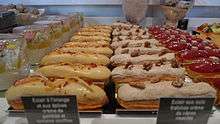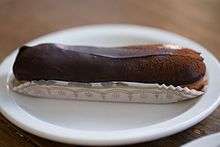Éclair
An éclair is an oblong pastry made with choux dough filled with a cream and topped with chocolate icing. The dough, which is the same as that used for profiterole, is typically piped into an oblong shape with a pastry bag and baked until it is crisp and hollow inside. Once cool, the pastry is then filled with a vanilla-, coffee- or chocolate-flavoured[1] custard (crème pâtissière), or with whipped cream, or chiboust cream; and then iced with fondant icing.[1] Other fillings include pistachio- and rum-flavoured custard, fruit-flavoured fillings, or chestnut purée. The icing is sometimes caramel, in which case the dessert may be called a bâton de Jacob.[2]
 | |
| Type | Pastry |
|---|---|
| Place of origin | France |
| Associated national cuisine | French cuisine |
| Main ingredients | Choux pastry, flavoured cream filling, icing |

Etymology
The word comes from the French éclair, meaning "flash of lightning", so named because it is eaten quickly (in a flash).[3]
History
The éclair originated during the nineteenth century in France where it was called "pain à la Duchesse"[4] or "petite duchesse" until 1850.[5] The word is first attested both in English and in French in the 1860s.[6][7] Some food historians speculate that éclairs were first made by Antonin Carême (1784–1833), the famous French chef. The first known English-language recipe for éclairs appears in the Boston Cooking School Cook Book by Mrs. D.A. Lincoln, published in 1884.
North America
Some pastry chains in the United States and Canada[8] market Long John doughnuts as éclairs or éclair doughnuts. Long Johns are not identical to éclairs, as Long Johns use doughnut pastry, which is yeast-risen or batter-derived, rather than choux dough, which is steam-puffed. Long Johns are usually filled with vanilla pudding or custard and topped with cake icing. In Lima and Kenton, Ohio, these are more commonly known as "filled sticks".
See also
References
- Montagné, Prosper, Larousse gastronomique: the new American edition of the world's greatest culinary encyclopedia, Jenifer Harvey Lang, ed., New York: Crown Publishers, 1988, p. 401 ISBN 978-0-517-57032-6
- (Montagné 1961, p. 365, Éclair)
- Éclair Archived 2014-01-04 at the Wayback Machine, Dictionnaire de l'Académie française, 8th edition
- (Gouffé 1873, p. 288)
- (Montagné 1961, p. 357, Duchesses)
- Oxford English Dictionary, 1861. Petit Larousse, 1863.
- Gouffé, Jules (1873). "Entremets détachés". Le Livre de Pâtisserie (PDF) (in French). Paris: Hachette. p. 288. Retrieved 2009-03-24.
On a changé, depuis une vingtaine d'années, le nom de ces gâteaux [pains à la duchesse] : on les désigne actuellement sous le nom d'éclairs.
- "Krispy Kreme Doughnuts". www.krispykreme.com. Archived from the original on 27 October 2017. Retrieved 4 May 2018.
Bibliography
- Gouffé, Jules (1873). "Deuxième Partie, Chapitre IX, "Pains à la duchesse au café"". Le livre de pâtisserie.
- Montagné, Prosper (1961). Larousse Gastronomique, The Encyclopedia of Wine, Food & Cookery (English translation).
External links
| Wikimedia Commons has media related to Éclairs. |
| French Wikisource has original text related to this article: |